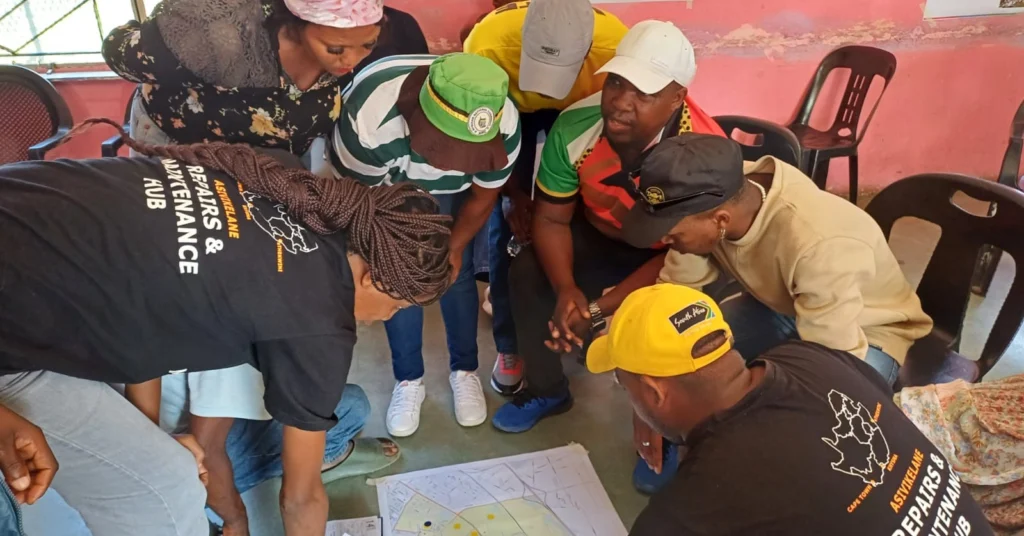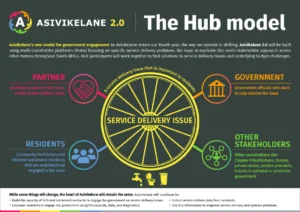Collaborating for Responsiveness? Asivikelane’s Evolving Approach to Community Engagement with Government – Part 2

Collaborating for Responsiveness? Asivikelane’s Evolving Approach to Community Engagement with Government to Improve Service Delivery in South Africa – Part 2
In 2020, during the COVID pandemic, a coalition of South African civic organizations launched the Asivkelane (‘Let’s protect one another’ in isiZulu) campaign. Asivikelane created a platform across South Africa’s eight largest cities for urban informal settlement residents to engage with government on basic water and sanitation (WASH) service delivery needs. To date, Asivikelane has contributed to thousands of service delivery improvements reaching millions of informal settlement residents. Asivikelane is part of the SPARK program supported by the International Budget Partnership.
As outlined in a previous blog, Asivikelane’s approach to improving government responsiveness evolved over time and achieved important progress at community, city and national levels. This blog will focus on the broader lessons that can be drawn from the Asivikelane experience on collaborative approaches to government responsiveness.
How to balance collaboration and independence for responsiveness and accountability?
Advantages of collaborative approaches
Asivikelane’s evolving collaborative approach has contributed to many positive responses from diverse city and national government actors, as well as private service delivery contractors. This is more notable given prevailing unresponsiveness of city authorities to informal settlements at the time Asivikelane was initiated. Asivikelane’s collaborative approach was also a significant divergence from the service delivery protests that were increasingly common in South Africa at the time. It’s not hard to understand why those who feel totally excluded in the dominant governance model would feel that their only option is visible and disruptive protests. However, isolated and fragmented protests may trigger a repressive reaction by power holders or lead to one-off palliative responses aimed at demobilizing citizens rather than addressing their real concerns. In the South African case, it is not clear that frequent but largely uncoordinated protests were leading to improved public services.
The Asivikelane approach is based on a deep understanding of the barriers that undermine city government responsiveness to informal settlement WASH service delivery needs and priorities in South Africa’s urban public resources governance system. This includes:
- Capacities, incentives and mindset of individual government actors
- Relationships and power dynamics among and between government, service providers and community
- Underlying bottlenecks from national to city to local levels.
Asivikelane’s evolving approach has sought to work across the factors shaping or constraining government responsiveness. Elements of this multi-dimensional engagement include:
- Asivikelane’s community data provides information about service delivery gaps and the engagement by community facilitators allows for this evidence to be enriched with the knowledge and perspectives of the community, which may be both more persuasive and informative for government actors.
- Engagement between community members and government actors on the basis of evidence and understanding can influence the attitudes and expectations of government actors towards informal settlement residents, moving towards seeing them as credible and capable partners in improving service delivery.
- Asivikelane’s evidence at city-level and across eight major urban areas can provide city and national decision makers with information about patterns of service delivery gaps. These are buttressed by further research into the specific bottlenecks driving these gaps in and across cities that can inform decision makers about needed systemic reforms.
- Collaborating with government actors at city or national levels that have oversight over the bureaucrats and service providers responsible for direct service delivery implementation can generate or strengthen the incentives of the latter actors with respect to their responsiveness to informal settlement priorities. A clear example is the collaborative relationship between Asivikelane and the Auditor General.
Thus, by establishing and building upon a credible and collaborative foundation for engagement with government, Asivikelane was able to increasingly work to address multiple barriers to responsiveness across levels of government. Isolated service delivery protests or even more sophisticated contestation strategies often fail to fully assess the range of factors for why the public resource governance system is stuck in a low responsiveness equilibrium, and thus often fail to make meaningful progress.

Risks of collaborative approaches
Despite its potential advantages, collaborative engagement for responsiveness is no silver bullet. When community engagement clearly leads to government responsiveness, it is easy to justify this approach. However, when collaborative engagements only generate one-off or partial responses, then questions are likely to arise about whether to continue this approach or adopt stronger pressure tactics.
Narrow Approach: One risk is that collaborative engagement does not sufficiently address the range of actors and factors that shape, enable and constrain responsiveness in service delivery. For example, Asivikelane’s original approach relied heavily on providing community-based information to government with the expectation that the incentives were in place for government to be responsive to these inputs, which was often then case initially. Over time, Asivikelane found that information alone was insufficient to enable meaningful and sustained government responsiveness, particularly for more complex issues such as service delivery to informal urban settlements. This aligned with many other similar experiences of civic actors seeking to ‘close the feedback loop’ with citizen-generated information.
Discretionary Responsiveness: A second risk for collaborative engagement is that government actors are responsive, but that their actions remain at their individual discretion rather than following clear processes or rules. Such discretionary responsiveness can fall within existing patterns of patronage and/or a desire to be seen as responsive, in both cases leaving in place asymmetries of power between communities and government actors, thus raising questions about sustainability. This is particularly true if this discretionary responsiveness is only generated by continuous community participation. The Asivikelane evolution suggests that community actors do not have unlimited time or patience to continuously engage government. If only the few most dedicated community actors sustain their engagement government, it can be easy to fall back into the low responsiveness equilibrium described above.
Fragmentation: Finally, if collaborative engagement does not lead to meaningful and sustained responsiveness, in addition to many community actors demobilizing, others might push for a more confrontational approach. This might include protest or ‘naming and shaming’ in media or legal sanctions. While these are valid tactics in the broad repertoire of civic advocacy and engagement, disagreements on approach may divide a community or coalition, leading to a fragmented and incoherent set of actions seeking responsiveness. When the underlying constraints on government responsiveness are not analyzed and understood, shifting to confrontational tactics could be counterproductive, for example by singling out actors who themselves face underlying constraints to being responsive to community needs, due to bottlenecks in budget and service delivery systems, for example.
Overall, collaborative engagement with government needs to be informed by a broader analysis of the actors and factors shaping and constraining responsiveness and service delivery, including the power dynamics that could reinforce discretionary responses and the bottlenecks that could undermine the capability of government actors and service providers to respond to community priorities. This initial and ongoing analysis by collective civic actors and their government allies can inform more nuanced, adaptive and systemic approaches to collaborative engagement, rather than more linear or simplistic approaches.
Asivikelane’s evolving approach to engagement for collaboration
Asivikelane’s evolution reflects a continued deepening of understanding of the actors and factors in the public resource governance system that shape (both constraining and enabling) responsive service delivery for informal settlements in South Africa. This includes sophisticated analysis of public financial and service systems as well as nuanced understanding of the capacities, incentives, relationships and attitudes of individual government actors and service providers. Asivikelane’s progress and limitations raised questions about whether the campaign was generating a significant volume of more individual responses, or whether this was translating into more sustained responsiveness, a key question for many civic actors assessing their engagement with government.
Asivikelane’s Hub approach reflects the progress, limitations and lessons learned from several years of increasingly intensive collaborative engagement with city and national governments. Ultimately, the collaborative multi-stakeholder Hub approach requires a minimum enabling environment to undertake holistic approach to addressing the specific set of barriers and bottlenecks to addressing a given WASH service delivery issue in a particular city context. However, Asivikelane does continue to engage with the Auditor General, media and other actors in the accountability ecosystem to shape align incentives for responsiveness.
Overall, Asivikelane demonstrates that there is no silver bullet or single pathway to responsive public services. Rather, Asivikelane provides a platform for informal settlement residents and their allies in civil society and government to understand, navigate and – over time and where possible – collaboratively shift the formal and informal public resource governance system that enables and constrains responsive service delivery. This requires incentives, attitudes, trust and relationships to work collaboratively across differences in roles, responsibilities, and life experiences. These are key enablers that Asivikelane has worked hard to establish, maintain, and leverage for meaningful change in urban service delivery in South Africa. The campaign continues to learn and adapt both its overall approach and the engagements it supports among specific hubs of stakeholders in order to deepen and sustain responsiveness going forward.
Meet the Explorers
Join the Governance Explorers
We are bringing together a global network of people eager to rethink governance and influence local, national and global debates.



